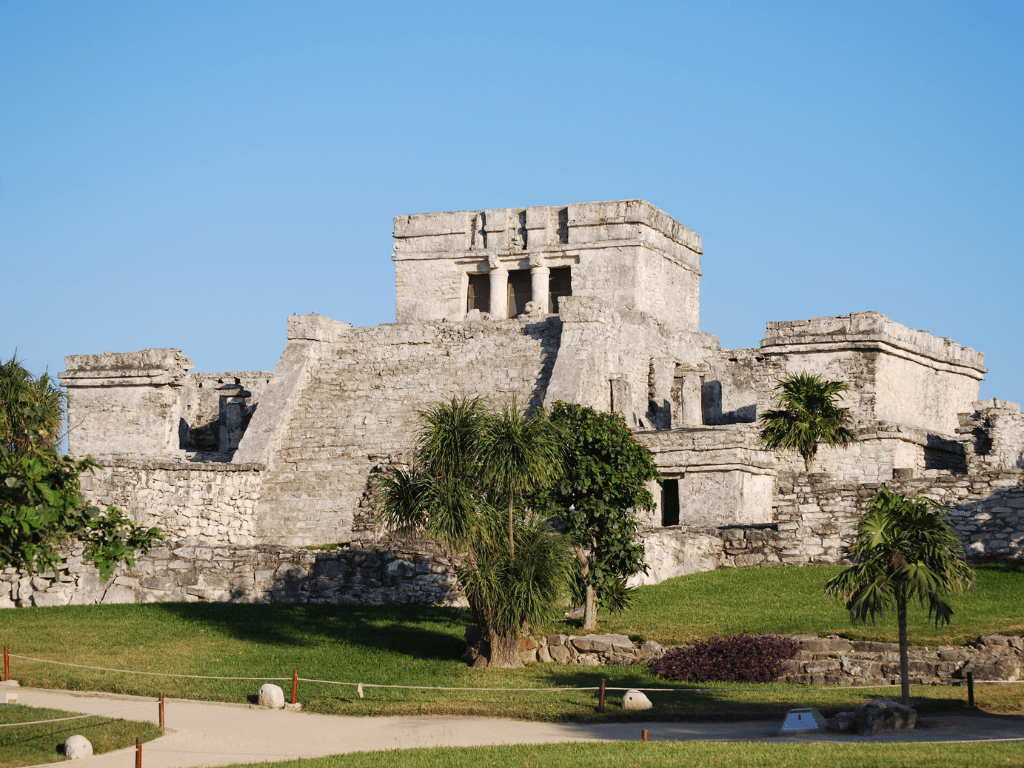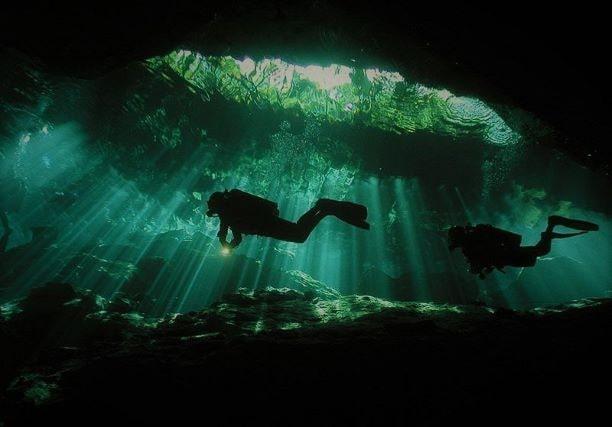Tulum: A Slice of Paradise in Mexico

Setting the Scene: A Beautiful, Serene Beach Town in Mexico
When you think of a perfect beach vacation, what comes to mind? Palm trees swaying in the breeze, crystal clear water lapping at your toes, and a laid-back atmosphere that allows you to truly unwind and relax. That’s exactly what Tulum offers.
This small town on the Caribbean coast of Mexico is a true slice of paradise. The beaches in Tulum are simply stunning.
White sand stretches for miles, and the water is so clear it’s like looking into a swimming pool. Whether you want to swim, snorkel, or just lounge on the beach with a book and a cold drink, there’s no better place to do it than here.
But Tulum isn’t just about beaches – it’s also home to some of the most stunning natural wonders you’ll ever see. Cenotes (natural swimming holes) are scattered throughout the area, offering visitors an opportunity to explore an underground world filled with crystal-clear water and amazing rock formations.
Brief History of Tulum and Its Significance
Tulum has been around for centuries – it was one of the last cities built by the Mayans before their civilization was wiped out by Spanish conquistadors. The ruins that still stand today offer a glimpse into this ancient culture and its architectural achievements. In recent years, Tulum has become one of Mexico’s top tourist destinations – but thankfully it hasn’t been overtaken by high-rise hotels and chain restaurants like some other popular beach towns.
Instead, visitors can enjoy a laid-back atmosphere that celebrates local culture and community. Tulum is also known for its commitment to sustainability and eco-tourism.
Many hotels use solar power or other environmentally friendly practices, while tours focus on preserving natural habitats rather than exploiting them for profit. All of these factors combine to make Tulum a truly unique and special place.
It’s not just another beach town – it’s a community that celebrates natural beauty, cultural heritage, and responsible tourism. If you’re looking for a vacation that will allow you to truly unwind and reconnect with the world around you, there’s no better place than Tulum.
The Beaches of Tulum

An Overview of the Beaches in Tulum
Welcome to paradise. The beaches in Tulum are unlike any other you’ve seen before. The crystal-clear, turquoise water that stretches out for miles is enough to take your breath away.
It’s impossible to pick just one beach as the best because each one has its own unique charm. The main beach, Playa Paraiso, is a must-visit for anyone coming to Tulum.
The beach is lined with palapas (thatched umbrellas) and lounge chairs where you can relax and soak up the sun. Take a dip in the calm waters or grab a paddleboard or kayak rental to explore further out.
Another popular beach is Playa Ruinas, located right next to the Mayan ruins. While it may not be as secluded as some of the other beaches, it still offers stunning views and plenty of space to spread out.
Insider Tips on the Best Beaches to Visit
If you’re looking for a more secluded spot away from the crowds, head over to Playa Santa Fe. This hidden gem is tucked away behind some trees and offers a tranquil escape from the hustle and bustle of some of the more popular beaches.
For those who want an even more remote experience, check out Xcacel Beach. You’ll need a car or taxi ride to get here since it’s about 20 minutes outside of town, but trust me – it’s worth it.
This protected stretch of coastline is home to sea turtles who come ashore during nesting season (June-October). Another great option is Playa Pescadores, which translates to “Fishermen’s Beach.” This beach isn’t as well-known among tourists but has plenty of character with its small fishing boats dotting the shoreline.
Hidden Gems and Secret Spots for a Secluded Beach Experience
If you’re willing to venture off the beaten path, you’ll find some truly hidden gems in Tulum. One such spot is Playa Akun, located about 15 minutes south of the main town. The beach is only accessible by foot or bike and has a more rugged feel to it with its rocky coastline.
If you’re looking for a truly secluded experience, check out Playa Xpu-Ha. This beach is about 30 minutes outside of town and requires a bit of an off-road adventure to get there, but once you arrive, you’ll have the entire beach practically to yourself.
If you want an Instagram-worthy shot that will make all your friends jealous, head over to the swing on Playa Pocna. This swing is located right on the beach and offers stunning views of the ocean – just be prepared for a wait since it’s quite popular among tourists.
Whether you’re looking for a party atmosphere or a quiet escape from reality, Tulum’s beaches have something for everyone. Don’t be afraid to venture off the beaten path and discover some hidden gems – trust me, it’s worth it!
The Mayan Ruins of Tulum

Lost in Time: The Background on the Mayan Civilization
Tulum is a beach town that boasts some of the most well-preserved and historically significant ruins in all of Mexico. Built by the ancient Mayan civilization around 1200 AD, these ruins have stood the test of time and continue to amaze visitors with their beauty and grandeur.
The Mayans were a complex society whose culture and way of life are still shrouded in mystery, but we know enough about them to appreciate their incredible achievements. The Mayans were skilled architects, mathematicians, astronomers, and artists.
They built impressive structures without the use of modern technology or machinery, such as El Castillo, which stands at over 40 feet tall and was designed to align with the sun during the summer solstice. The ruins at Tulum offer a glimpse into this fascinating civilization’s history and provide valuable insights into their way of life.
The Ruins: A Description of its Historical Significance
The ruins themselves are a sight to behold. The ancient structures are built from limestone blocks that were quarried nearby and reflect elaborate carvings that tell stories about gods, rulers, and daily life in pre-Columbian times. The most famous building at Tulum is El Castillo, which was once used as an astronomical observatory by Mayan priests.
It also served as a lighthouse for sailors. Other notable structures include Templo de los Frescos (Temple Of Frescoes), which contains murals depicting Maya deities adorned with jewelry; Temple Of The Descending God reflects how important religion aspect was to this culture; Gran Cenote – one of many cenotes – has some fine examples of stalactites within (the natural formations hanging down from ceilings) along with crystal clear water for snorkeling around.
Tips for Exploring the Ruins
To get the most out of your visit to Tulum’s ruins, it’s important to plan ahead. Bring sunscreen and water, as temperatures can soar during the day, wear comfortable shoes and clothes. If you’re not a fan of large crowds, avoid visiting during peak season (December through April), when lines can be long and the sites can get crowded.
Consider hiring a local guide to provide an in-depth understanding of the history and significance of each structure. Don’t just rush through the ruins; take your time to appreciate every detail, from intricate carvings to breathtaking views of the ocean from atop El Castillo.
Be respectful of these ancient structures – don’t touch or climb on them – so that future generations can enjoy their beauty too. With some planning and preparation, exploring Tulum’s Mayan ruins is an unforgettable experience that will leave you with a newfound appreciation for this incredible civilization.
The Cenotes of Tulum

Exploring the Wonders of Natural Sinkholes
Tulum is known for its captivating cenotes, which are natural sinkholes filled with crystal-clear water. These cenotes play an essential role in Mexican culture, as they were once used for both ceremonial and practical purposes.
Today, they are a major tourist attraction in Tulum, and it’s clear to see why. Cenotes are formed over thousands of years by the erosion of limestone rock through groundwater.
They come in various shapes and sizes, each with their unique features that make them worth exploring. Some cenotes such as Gran Cenote and Dos Ojos have incredible underwater cave systems that make them great for diving enthusiasts.
Overview of the different types of cenotes found in Tulum

There are four primary types of cenotes found in Tulum: open-air, semi-open-air, cave and ancient sinkholes. Open-air cenotes have a shallow basin that is open to the sun and sky above; semi-open-air cenotes have a partial air opening; cave cenotes occur within underground caverns or caves; ancient sinkholes are dry or almost-fully silted up but retain significant cultural value.
Open-air cenotes such as Casa Cenote offer a beautiful experience where you can appreciate their surroundings while swimming or snorkeling at your own pace. Semi-open-air options like Cenote Samula offer natural light peeking through from above giving visitors a unique swimming experience.
Cave or underground river systems like the breathtaking Sac Actun system provide an otherworldly experience filled with mystery around every turn. Ancient sinkholes which include much historical significance such as Ik Kil attract tourists from all around the world for its rich history.
Recommendations for which cenotes to visit based on interests
Depending on your interests, some cenotes may be more appealing than others. If you are into diving, Gran Cenote or Dos Ojos cenotes should be at the top of your list.
For those interested in exploring underground river systems, make sure to visit Sac Actun. Additionally, there are many options for adrenaline junkies like rappelling into Cenote Kin-Ha or snorkeling in Cenote Calavera.
For visitors looking for a more serene experience, Casa Cenote provides the perfect setting to feel relaxed while enjoying the natural beauty of Tulum’s cenotes. For those who want something with a bit of history deeper than swimming in clean water and adorned with stalactites make sure that Ik Kil is on your itinerary.
Overall, Tulum’s cenotes are one of its most unique and breathtaking landmarks that offer both adventure and relaxation in one package deal. With so many options to choose from based on your interests and preferences, taking time to explore them is guaranteed to be an unforgettable experience.
Eco-Tourism in Tulum

Why Eco-Tourism Matters in Tulum
Tulum is a small but beautiful town located on the Caribbean coast of Mexico. With its crystal-clear waters, white sand beaches and lush jungle landscape, it’s no wonder Tulum has become an eco-tourism haven.
Ecotourism refers to responsible travel to natural areas that conserves the environment while also benefiting local communities. In Tulum, this means supporting local businesses that promote sustainability and being mindful of one’s impact on the environment.
Tulum’s economy largely relies on tourism, which is why eco-tourism plays such an important role in the town’s development. By promoting sustainable practices and responsible travel, we can ensure that Tulum remains a beautiful destination for years to come.
Eco-Friendly Activities in Tulum
There are plenty of eco-friendly activities available in Tulum for travelers who want to experience the beauty of the area without harming it. Snorkeling with sea turtles is a popular option as it provides an opportunity to see these majestic creatures up close while supporting conservation efforts.
The turtles are protected by law, so it’s important to choose a tour operator who follows regulations and promotes ethical practices. Visiting a sustainable farm is another great way to support eco-tourism in Tulum.
Many farms grow organic produce and use environmentally friendly practices such as composting and rainwater harvesting. By visiting these farms, travelers can learn more about sustainable agriculture while also supporting local businesses.
Responsible Travel Tips for Eco-Tourists
While enjoying eco-tourism activities in Tulum, it’s important to be mindful of your impact on the environment and local community. Here are a few tips for being a responsible traveler: 1) Support local businesses that promote sustainability: This could mean choosing hotels and restaurants that use renewable energy or support conservation efforts.
2) Reduce your carbon footprint: Consider using public transportation or renting a bike instead of driving a car. You could also pack reusable water bottles and utensils to minimize waste.
3) Respect local customs and culture: Learn about the local culture before you arrive and show respect by dressing appropriately, using appropriate language, and following cultural norms. 4) Leave no trace: Pack out what you pack in.
Don’t leave trash or other waste behind on beaches, trails, or other natural areas. 5) Use ethical tour operators: Choose tour operators who promote sustainable practices, follow regulations and have a commitment to protecting the environment.
Eco-tourism plays an essential role in Tulum’s development by promoting sustainable practices while also providing travelers with unique experiences that prioritize environmental conservation. By being mindful of our impact on the environment and supporting local businesses that promote sustainability, we can enjoy everything Tulum has to offer while ensuring its future beauty for generations to come.
The Food Scene in Tulum

Traditional Mexican Dishes to Savor
Tulum is a gastronomical paradise, and its traditional Mexican food cannot be missed. Some dishes are simple yet delicious, while others are complex and bursting with flavors. For breakfast, start your day with chilaquiles – a dish made of fried tortillas topped with salsa and eggs.
Another classic breakfast item is huevos rancheros – eggs served on a tortilla with beans, cheese, and salsa. For lunch or dinner, try cochinita pibil – slow-roasted pork marinated in spices and orange juice served on tortillas.
Tacos al pastor are a must-try when exploring the street food scene in Tulum. Prepared on vertical spits like doner kebab, the meat is shaved off onto corn tortillas and topped with pineapple chunks, cilantro, onions and hot sauce for an explosion of flavors in every bite.
The Rise of Veganism in Tulum
In recent years there has been an increase in veganism worldwide as people become more concerned about their health or the environment’s welfare. Tulum has not been left behind as more restaurants now offer vegan options on their menus. Restaurants such as Raw Love Cafe offer organic dishes sourced from local farms such as hummus bowls topped with falafel balls and fresh salads.
Sustainable Farm-to-Table Restaurants
Sustainability is integral to the way of life here that extends to dining experiences too! Many restaurants have started practicing sustainable techniques by growing their own produce organically without any harmful chemicals or pesticides.
One such restaurant is Hartwood which offers farm-to-table dining experiences where they source fresh ingredients from their own garden daily! Enjoy dishes like Mahi Mahi ceviche infused with citrus juices along with mouth-watering grilled octopus.
Conclusion
Tulum is a paradise for food lovers and an excellent destination for those who want to try delicious traditional Mexican cuisine. From vegan-friendly cafes to sustainable farm-to-table restaurants, Tulum offers something unique for every palate.
Whether you are a foodie or looking for a gastronomical adventure, Tulum will not disappoint! With its endless variety of fresh ingredients, rich culture and culinary traditions handed down through generations, there’s no doubt that this town will continue to be one of the top food destinations in Mexico and indeed the world! Make sure to check out other Yucatan vacation destinations.
